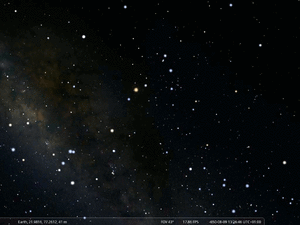Jyeshtha: Difference between revisions
From All Skies Encyclopaedia
Jyeshtha
No edit summary |
No edit summary |
||
| Line 3: | Line 3: | ||
[[File:18 Jyeshtha draw.png|thumb|Depiction of the 18th nakshatra, Jyeshtha, in temples.]] |
[[File:18 Jyeshtha draw.png|thumb|Depiction of the 18th nakshatra, Jyeshtha, in temples.]] |
||
[[File:17-19 nakshatra stellarium.gif|thumb|The 17th, 18th, 19th nakshatra mapped to the Stellarium base chart, animated GIF, WGSN 2025: Jyeshtha is the middle one. ]] |
[[File:17-19 nakshatra stellarium.gif|thumb|The 17th, 18th, 19th nakshatra mapped to the Stellarium base chart, animated GIF, WGSN 2025: Jyeshtha is the middle one. ]] |
||
Jyeṣṭha (ज्येष्ठा) is an Indian name, used by the Indian Vedic tradition. Most of these names are roughly 3000 years old. They pre-date Hinduism but were taken over by it. |
Jyeṣṭha (ज्येष्ठा), The Eldest, is an Indian name, used by the Indian Vedic tradition. Most of these names are roughly 3000 years old. They pre-date Hinduism but were taken over by it. |
||
==Etymology and History== |
==Etymology and History== |
||
Revision as of 15:35, 13 October 2025
Jyeṣṭha (ज्येष्ठा), The Eldest, is an Indian name, used by the Indian Vedic tradition. Most of these names are roughly 3000 years old. They pre-date Hinduism but were taken over by it.
Etymology and History
Name Variants
- Jyeṣṭha,
- Jyeshtha,
- Śakra,
- Aindra
Origin of Constellation
The asterism is depicted as a group of three stars and typically identified with the bright star Antares (α Sco). As the term "nakshatra" literally means "not bright", it is more likely that the stars surrounding Antares, τ and σ Scorpii plus i Sco (or d Sco?), were interpreted as an asterism framing the bright star in the center.
Jyeshtha is also the name of a goddess.
Transfer and Transformation of the Constellation
Mythology
mnemonic tales and cultural significance
Weblinks
References
- References (general)







